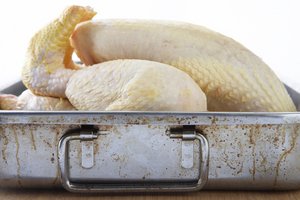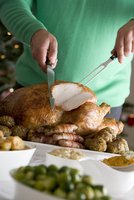How-To-Cook-A-Turkey
How To Carve A Turkey
How To Make Turkey Gravy
Turkey Dressing
Novice? How-to-cook-a-turkey isn't difficult to learn. What's most important is the turkey-cooking-temperature for safe eating conditions.
You know it's going to be turkey time (twice perhaps within a short period) when Fall rolls around.
The weather cools off, children return to school, the leaves on the trees are quickly changing to beautiful colors, Halloween is coming, and you suddenly feel like you have some big events to think about.
Thanksgiving and Christmas are just around the corner, and if you want to learn how-to-cook-a-turkey dinner for both, which most people do, it's not that difficult, even for a beginner cook. Once you know how-to-cook-a turkey, it becomes a pleasant experience and not an intimidating one.
Realize you will have leftovers.
Turkey leftovers are a wonderful thing especially if you have kids looking for yummy school lunch sandwiches, sandwiches for you or your husband's lunch for work, or even just to give busy moms a day off from cooking.
The nice thing about turkey, is that it's one of the best meats that make the most use of leftovers. Used up properly, there is no waste, and it stretches a very very long way. Good for our carbon-footprint!
There are a number of great recipes out there for turkey soups, turkey casseroles, turkey burgers and meatloaf, all kinds of things.
Get your shopping list ready. A small turkey (we find 12 - 14 pounds) will do just nicely, and that's to feed 4 or 5 people. This doesn't take long to cook and there will still be enough for sandwiches and much more easily the next day.
Order your turkey early especially if you want fresh. Sometimes vendors sell out early, and only take these special orders at peak time.
If you have a store-bought frozen turkey, allow it time to thaw over a few days in the refrigerator.
If you leave it on your kitchen counter, bacteria can form and you don't want everyone sick from food poisoning. This is one of the most important rules of learning how-to-cook a-turkey. Preparation is important too.
Poultry should always be kept cold.
If still a bit frozen in spots on cooking day? Speed up the defrosting process by running cold water over it in the sink. Sit it on a plate or on some plastic first.
Once the turkey has defrosted, time to get it ready for cooking.
Check Turkey-Cooking-Times as per
Cooking Label Instructions
How big should your turkey be?
According to "calculations" you should plan on 1 1/2 pounds of meat per person. But don't worry about it being too big; remember, it freezes well. If you want to perfect your turkey roasting skills and abilities, start with a small turkey and go from there.
As for turkey-cooking-times, figure on 15 minutes cooking per pound. If your turkey is stuffed, it will take a little bit longer, maybe 20 minutes instead.
The packaging may indicate how many hours per pound or time per kilo to cook. When it comes to how-to-cook-a-turkey, I still go on my own instincts.
I put the bird in the oven around noon at 375F and turn it down around noon, start it out at 350F or 375F and I may turn it down to 325F around 4. I usually remove the cover to let the skin crisp up in the last hour of cooking.
Regardless, it's always ready to eat between 5 and 6 pm. Turkey cooking times vary with different people as to exactness, but basic turkey-cooking-instructions are very similar generally.
Take the wrapping from the bird and throw it away. Look for the wrapped packages of the gizzard and neck usually found in the cavities.
What I do, is rinse these off well, and put them in a little water in small sauce pan and place on the stove on low heat to simmer all day. At the end of the day, my cats get a treat from the liver and other parts, and I use the juices for gravy (not all, but some); I take the meat from the neck for gravy too. If know I'm going to make soup, I freeze the neck for later.

Rinse the turkey thoroughly in ice cold water inside and out.
I'm quite picky about this, and I am very thorough with cleaning the turkey cavities. Make sure the water runs clear.
If there are any feather pieces, pull them out. Using paper towel, soak up the moisture from the bird.
Place it in the pan with the turkey breast side up.
You need a deep pan for roasting, and a rack to place in it that will keep the turkey from soaking in juices on the bottom for hours. Put just an inch and a half of water in the bottom of your pan.
Are you stuffing your turkey or cooking the stuffing on the side?
Some people prefer on the side. The reason for that is, stuffed turkeys can sometimes encourage a good place for bacteria to form, and can interfere with the complete cooking of the dressing and the turkey meat. If you do prefer your stuffing baked separately, I would salt the turkey cavities a little and then place a little bit of cut up onion inside for enhancing extra flavor.
How-to-cook-a-turkey properly means dealing with these other issues as well.
Stuffing is easy to do I think, and if you are interested in homemade instead of out of the box, here is how I do it.
How-To-Cook-A-Turkey Dressing
I plan ahead, and put any leftover bread in any form (rye bread, bagels, whole wheat, brown, white etc.) in the freezer. On the day I need it, I take out enough bread to fill up a large bowl in the morning, and let it defrost. I then break it up into small cube-sized pieces.
If you are learning how-to-cook-a-turkey, learn to make a nice dressing as well. A variety of breads makes a nice difference!
In the meantime, I put a generous spoonful of butter into a deep frying pan, and set on low.
Add bacon bits, chopped up celery, onions, a bit of carrot and place in the frying pan. Let simmer until cooked down.
Season with salt, pepper, basil, and sage. Remove from the stove and mix it well with the cubed bread. Add an egg when the mixture has cooled. Add a cup of boiled water and continue to stir. Add an egg when the mixture has cooled and stir again. Stuff the turkey cavity well. Any leftover stuffing can be cooked in a baking dish in the oven covered with foil. Remove the foil a half hour before serving time to let the top of the stuffing get browned and crispy.
Just like how-to-cook-a-turkey, how to make dressing is to taste. You can add apple, or other types of vegetables later if you like. I don't think you can go wrong with dressing myself, unless you go overboard on the herbs.
How-To-Cook-A-Turkey
Seasonings
Take some soft butter and brush the turkey skin, and don't forget to be thorough here either. Make sure to get the legs, and wings and all the little nooks and crannies. Sprinkle with whatever you like for seasoning.
I would use a little salt, pepper, a touch of garlic powder and paprika for color. You can use lemon pepper if you prefer, or a little Montreal chicken spice is something I've discovered lately.
You may want to give it a little sprinkle of onion soup mix; just a little bit though. These seasonings will drip down as the turkey cooks and be very helpful when making your gravy.
Cover your turkey with a tight fitting lid, or tin foil.
After seasoning the turkey, place it in the preheated oven.
Checking it frequently, allow the turkey to cook for the correct amount of time as indicated by the label. Once the skin begins to brown, take the turkey out and give it a nice basting with the juices. Recover the turkey again well, and pop it back into the oven.
You can baste as often as you like.
How-To-Cook-A-Turkey Gravy
As you get close the end of the turkey cooking time, think about how-to-cook-a-turkey gravy.
Take a look at the neck that's been simmering on the stove since the turkey started cooking. Take some juices from there and take the juices that have collected at the bottom of the turkey pan using a ladle. Mix, and start this simmering on the stove.
In the meantime, I mix up a little cold water, a few spoons of cornstarch and salt and pepper. You can use flour as well.
The trick is to make sure the liquid is on a low rolling boil in the saucepan first. Be sure your flour or cornstarch paste is mixed very well and is smooth. No lumps!
Flour lumps can ruin your gravy and fill your gravy liquid with tiny cooked balls of "goo." I've had it happen.
Once you are satisfied the paste is smooth, stir it in quickly and keep stirring well; don't forget to include scraping the bottom of the pot for flour or starch that might have settled there. Your gravy should begin to thicken immediately.
Turkey gravy, I find, isn't sometimes as tasty as I expected.
If this is the case, add a spoonful of onion soup mix in, or chicken broth cubes. There are powdered turkey gravies on the market that can be used sparingly just to help the gravy along. You may find you don't need to anything at all. Nice to be prepared though.
Once your gravy has started to thicken, reduce the heat to low, and just let it sit until you serve dinner. Give it a stir occasionally. Refrigerate after dinner.
You may see a thickened layer of fat on top in the morning; spoon spoon this out and you will still be left with a lovely gravy, just minus some fat.
Sometimes turkeys come with a little pop-out that tells you the turkey is ready to come out of the oven. Watch for it to pop out, and when it does, take the turkey out of the oven. Otherwise, take it out, and be sure that like chicken, juices are running clear. Cut into the meat and judge like you would chicken.
The turkey needs to rest for a half hour in order to let the meat soak back up the juices, and it will still keep cooking while covered with foil. Also this allows the turkey to cut more easily, and remain juicy at the same time.
How-To-Cook-A-Turkey
Carving

After the resting period, it's time to start carving.
Have a large platter ready and a sharp knife. Begin by removing the wings and the legs by slicing the joint and applying a bit of pressure.
When you have these removed, start slicing the white breast meat. Just slice evenly and thinly and place on the platter alongside the legs and wings.
If you like dark meat, you will find it on the bottom of the turkey, underneath the wings. Make sure to have a nice selection of white and dark meat on your platter.
How-to-cook-a-turkey dinner traditionally with lots of other dishes like potatoes, salads, desserts, stuffing etc., can be a big deal if you don't know how-to-cook-a-turkey at all, and especially if this is your first time putting on this dinner for a group.
There's nothing wrong with doing your potatoes and vegetables the day before either and keeping them refrigerated until turkey day.
If there is one other good tip I could give when learning how-to-cook-a-turkey, it would be clean up as you go along.
Keep your cooking space tidy, clean and clear.
Leave How-To-Cook-A-Turkey
Return To Eco-Friendly Thanksgiving
Return To Carbon-Footprint Defined Home Page

Thanks For Your Support
Green Maven!

Popular Tips
Recycling Tips
Garage Sale Tips
Laundry Room
Green Travel
The Company Money
Eco-Baby Gift
Make A Diaper Cake







